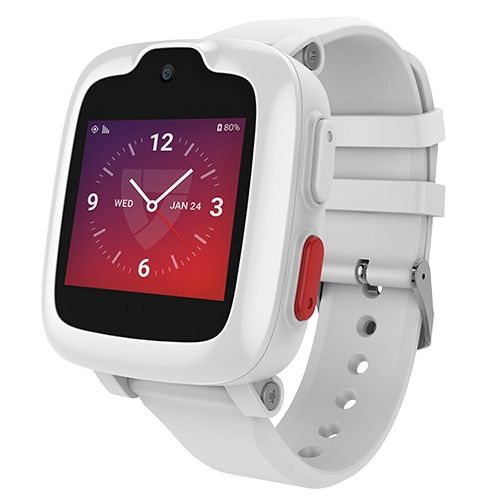Medical alert systems have come a long way since LifeAlert’s famous “I’ve fallen and I can’t get up” commercials in the 1980s. Today, you can find medical alarms that cater to the needs of both active and home-bound older adults. Modern systems can do anything from automatically detecting a fall to pinpointing your loved one with GPS if they get lost.
Medical alert systems range from one-button systems to smartwatches with activity features. You can even find medical alert devices for vehicles. But they all essentially do the same job—call for help when it’s needed most.
Picking the best medical alert system for your loved one depends on their activity level, your budget, and extra features they may need (like automatic fall detection). We recommend taking your time and exploring your options when you start the process. The best medical alert systems are flexible enough to fit most lifestyles.
Whatever alert system you choose, it needs to be comfortable and convenient enough for your loved one to have nearby 24/7.
Choosing the right medical alert device
1. Consider mobility
Medical alert systems need to go wherever your loved one goes, even if it’s just to the mailbox and back. When shopping for a medical alert device, consider how often they leave the house and where they spend most of their time inside.
At-home systems
If your parents or older loved ones are homebound or don’t drive, an at-home system might be the best choice. You’ll get a base unit and a wearable device (usually a pendant or wristband) that they can wear around the house.
Most systems have a range of 600 to 1,000 feet from the base station, allowing your loved one to move safely around their house and yard.
At-home medical alert systems can connect to a landline or use cellular technology (the same as your smartphone or security system). The system works the same for both connection types, but pricing for the different devices may vary. While going cellular makes the system easier to connect, landline systems generally cost less.
Wearable medical alerts
If your loved one is still driving, running errands, and staying active, you can find mobile medical alerts they can take with them. There’s generally more variety among wearable devices—from smartwatches to fashion-forward pendants. And they come with features like GPS tracking, messaging, and activity trackers.
2. Remember your budget
Budget is an obvious factor, but it’s worth spending a little more to know your loved one is safe. After all, this device is their lifeline in an emergency. So it’s important to purchase one they’re comfortable using.
Most medical alert systems charge a one-time equipment fee and a monthly monitoring fee. You’ll usually pay both fees up front when you first purchase the system. Then you’re responsible for the monthly monitoring fee until you decide to cancel or switch.
Here are the starter prices from the best medical alert systems. We’ve included the lowest monthly monitoring and equipment prices from each to give you an idea of the starting price range.
| Lowest monthly monitoring |
| Lowest equipment cost |
| Cost at checkout |
| Bay Alarm Medical | GetSafe | Philips Lifeline | Medical Guardian | MobileHelp |
 |
 |
 |
 |
 |
| $19.95 | $24.95 | $29.95 | $29.95 | $34.95 |
| $19.95 | $79.00 | $69.95 | $0.00 | $19.95 |
| $19.95 | $103.95 | $99.00* | $42.45 | $69.95* |
| Read Review | Read Review | Read Review | Read Review | Read Review |
Info current as of 06/02/2020. Offers and availability may vary by location and are subject to change.
*These prices include one-time processing or activation fees applied at checkout.
Equipment prices
Starting prices for medical alert systems can land anywhere between $20 and $200—this includes combined up-front costs for equipment, monitoring, and activation. From there, you typically pay only a monthly monitoring fee.
Bay Alarm Medical has a bare-bones starter system starting at $19.95 that requires a landline and comes with only a lanyard and base station. But this price doesn’t include add-ons like extra wearables or fall detection.
On the other hand, GetSafe charges $253.95 of its most advanced system for larger homes. It comes with five buttons, a base unit, and an alert pendant. After you buy the equipment, monitoring is only $24.95 per month.
The most important goal is to aim for a system that meets your loved one’s needs. If budget is still a concern, we’ve created a list of our favorite affordable medical alerts that can get you started.
Monitoring costs
Depending on the service and its features, monthly monitoring costs between $20 and $60 per month. The more devices in the system to monitor, generally the more expensive the monthly bill.
Wondering what exactly you’re paying for? Just like the pros who monitor security systems, the folks on the other side of a medical alert system can talk your loved one through a health emergency or find them if they get lost. They’re also the people who contact you and emergency responders when your loved one needs help.
Add-on features
Add-on features are usually a la cart items that make your system easier to use or more emergency ready. You can complement a system with extra SOS buttons, pendants, or wristbands.
Other common add-ons:
- Vial of life: a sheet with important personal information for emergency responders
- Lockbox: for your keys, medications, or other valuables
- Extra wearable devices: for you or your spouse
While most medical alert systems rely on preference, we recommend adding fall detection to your system (or at least considering it), especially if your loved one has taken a fall before.
Discounts happen—just ask!
Discounts are commonly given to veterans, lower-income folks, and people with multiple customers in a household. All you have to do is ask the customer service rep when you call.
3. Explore alert system features
Choose a medical alert system with features that fit your loved one’s lifestyle and your budget. You don’t have to say yes to every add-on and extra, but these are a few worth considering depending on your situation.
Automatic fall detection
According to the Centers for Disease Control, adults over 65 are more likely to be seriously injured when they slip or fall. Older adults may sometimes fall unconscious or break limbs in a tumble. In these dangerous situations, automatic fall detection can be crucial.
Most medical alert systems charge around $10 a month to add this feature to a system. The best medical alerts with fall detection can call for help even if your loved one is unresponsive or unconscious, cutting down on wait time to get them help.
GPS location
Freedom Guardian Smartwatch
- Three forms of GPS tracking
- Optional messaging and reminders
- One-touch help button
For seniors with dementia or developing Alzheimer’s, wandering off or getting lost can be a common problem. If your loved one is experiencing memory issues, consider looking for a medical alert device with GPS tracking.
Objects like buildings, trees, and even mountains can interfere with signals, so the best devices use multiple forms of tracking to get around these obstacles. When your loved one gets lost, you can find them with this type of wearable tracker.
Additional emergency buttons
Many medical alert companies have additional emergency buttons that connect with the main system through cellular or Bluetooth signals. With these, you can place a medical alert at the bottom of the stairs, in the bathroom, or anywhere in the house. They connect to the rest of the system and let you call for help wherever the button is.
If your parents or older loved ones live in a multi-level home, we recommend at least one emergency button per floor.
Caregiver mobile app
Some medical alert systems have a companion app for caregivers. You can talk to your loved one, see where they are, and respond to emergencies. These apps also make it easier for monitoring professionals at the response center to contact you in case of an emergency.
Two-Way communication
Two-way communication works like an intercom, allowing users to speak to monitoring professionals on the other side and provide info about an emergency.
Two-way communication is usually found in the base stations of at-home medical alert devices and wearables. It activates when wearers press the button to call the monitoring center for help.
FAQ
When does someone need a medical alert system?
There isn’t one answer to this, but we recommend you be proactive, not reactive.
If you notice your parents or loved ones are struggling with mobility or cognitive functions, consider finding a basic system they can use. To gauge their comfort level, learn how to talk to your parents about medical alert systems before buying.
My parents live out of state. Can a medical alert system help them?
Of course. When you add yourself as an emergency contact, you’ll be the second person monitoring professionals will contact (after emergency services). They can give you details about what happened and guide you on what to do next.
Do medical alert systems offer discounts?
Yes, but they aren’t usually advertised. When you find a medical alert system you’re interested in, give them a call and ask their sales reps about what’s available. Veteran discounts, membership discounts, and discounts for lower incomes are pretty common across the board.
Do medical alert devices call emergency responders?
Yes, through the professional monitoring center connected to the alert device. When a user presses the SOS button, monitoring pros on the other side will contact them to find out what happened. If the emergency calls for it, they will send emergency services to your loved one at their location.
Could I use my smartphone or smart speaker as a medical alert system?
Smartphones and smart speakers are both great tools, but they aren’t as reliable as medical alert systems. Smartphones aren’t always handy and nearby (like in the shower or the car). And while smart speakers can call contacts on your phone, they can’t call 911.
Smart home devices can help seniors with reminders, automations, and remote control for those with mobility issues.
The post How to Choose a Medical Alert System appeared first on SafeWise.
Article source here: How to Choose a Medical Alert System



No comments:
Post a Comment